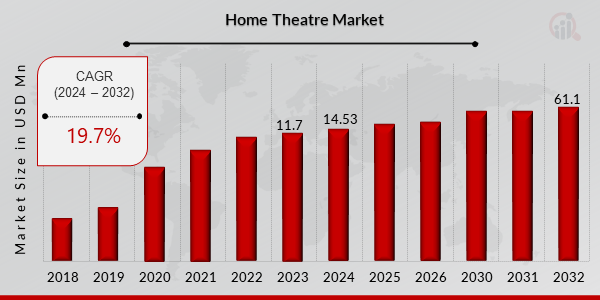The Cinematic Revolution at Home: An In-depth Look at the Home Theatre Market
The allure of the cinematic experience, once confined to dedicated movie halls, has steadily permeated our homes, fostering a robust and evolving Home Theatre Market. Driven by technological advancements, changing consumer preferences, and the proliferation of high-quality digital content, this market is transforming how we consume entertainment, bringing immersive audio and visual experiences right into our living spaces.
Market Size and Growth:
The global home theatre market is experiencing significant expansion. Valued at approximately USD 11.7 billion in 2023, it is projected to reach an impressive USD 61.1 billion by 2032, exhibiting a compound annual growth rate (CAGR) of 19.7% from 2024 to 2032. Other estimates vary slightly, with some reports predicting a market size of USD 16.40 billion by 2030 with a CAGR of 9.44%. Regardless of the exact figures, the consistent upward trajectory highlights a strong and sustained demand. This growth is a testament to increasing consumer spending on home entertainment devices and the widespread adoption of smart home ecosystems.
Key Market Drivers:
Several factors are fueling the growth of the home theatre market:
-
Rising Demand for Immersive Experiences: Consumers are increasingly seeking to replicate the cinema-like experience within their homes. This desire for superior sound and video quality is a primary driver, encouraging investment in advanced home theatre systems.
-
Proliferation of Streaming Services: The exponential growth of OTT (Over-The-Top) platforms like Netflix, Amazon Prime Video, and Disney+ has made a vast library of high-quality content readily accessible. With an increasing number of titles available in 4K UHD and immersive audio formats like Dolby Atmos, viewers are motivated to upgrade their setups to fully enjoy this content.
-
Technological Advancements: Continuous innovation in audio-visual technology is a key catalyst. This includes the development of 4K and 8K resolution displays, advanced immersive audio technologies such as Dolby Atmos and DTS:X, and enhanced HDR (High Dynamic Range) for superior color accuracy and contrast. Wireless connectivity options (Bluetooth, Wi-Fi 6E, WiSA 2.0) and smart home integration with voice assistants like Alexa and Google Assistant are also making home theatre systems more convenient and user-friendly.
-
Increased Disposable Income: A consistent rise in disposable incomes globally, particularly in emerging economies, empowers consumers to invest in luxury items and high-end entertainment systems.
-
Shifting Lifestyle Trends: Factors like the work-from-home trend and a general preference for home-based entertainment, especially intensified by recent global events, have significantly boosted the demand for premium home entertainment solutions. The rising popularity of “man caves” and dedicated entertainment spaces also contributes to this trend.
-
Affordability and Accessibility: While high-end systems cater to premium segments, the market also sees the introduction of more affordable yet high-quality options, making home theatre systems accessible to a broader consumer base.
Market Segmentation and Trends:
The home theatre market is segmented by product type, component, distribution channel, and region.
-
Product Type:
-
Home Theatre in a Box (HTIB): This segment has traditionally dominated due to its cost-effectiveness and bundled components, offering a complete audio-visual experience in one package.
-
Soundbars: Expected to be the fastest-growing segment, soundbars offer high-quality audio in a compact, user-friendly design. Their sleek aesthetics and ease of installation make them ideal for modern living spaces, integrating features like Dolby Atmos and wireless connectivity.
-
Component Systems: This segment caters to audiophiles and cinephiles seeking a truly customized and premium experience, involving separate AV receivers, speakers, and subwoofers.
-
-
Connectivity: While wired installations currently hold a larger share, wireless configurations are projected to grow at a higher CAGR, driven by advancements in wireless audio technology that reduce latency and offer greater flexibility.
-
Distribution Channel: Offline retail currently dominates as consumers prefer to physically audition sound quality before purchasing. However, online retail is expected to grow significantly due to the convenience, vast product range, and attractive offers provided by e-commerce platforms
Challenges in the Market:
Despite its robust growth, the home theatre market faces certain challenges:
-
High Initial Setup Costs: The cost of installing and customizing high-end home theatre systems can be a deterrent for budget-conscious consumers.
-
Space Constraints: In urban dwellings and smaller apartments, the requirement for dedicated space for larger speakers, projectors, and optimal acoustic setups can be a significant limitation. This drives demand for compact, integrated solutions.
-
Rapid Technological Changes: The quick pace of technological advancements can lead to shorter product lifecycles, making systems quickly outdated and impacting consumer purchasing decisions.
-
Competition from Alternatives: The market faces competition from increasingly sophisticated smart TVs with integrated speakers and compact, portable audio devices
Future Outlook:
The future of the home theatre market appears promising. Continued innovation will focus on integrating advanced technologies like AI-powered sound calibration, personalized audio settings, and seamless connectivity with broader smart home ecosystems. The market will also see a continued emphasis on aesthetically pleasing and compact designs to cater to diverse living environments. As content quality continues to improve and streaming services become even more ubiquitous, the desire for an enhanced, immersive home entertainment experience will remain a powerful driving force for market growth globally, particularly in developing regions like Asia-Pacific.
Key Players:
The home theatre market features a competitive landscape with both global giants and emerging brands. Key players include:
-
Sony Corporation
-
Samsung Electronics Co., Ltd.
-
LG Electronics Inc.
-
Bose Corporation
-
Yamaha Corporation
-
Panasonic Corporation
-
Harman International Industries (JBL)
-
Koninklijke Philips N.V.
-
Sonos Inc.
-
Vizio
-
Pioneer Corporation
These companies are actively engaged in product launches, strategic partnerships, and investments to capture market share and cater to evolving consumer demands.
In conclusion, the home theatre market is a dynamic and expanding sector, driven by a universal desire for high-quality, immersive home entertainment. As technology continues to advance and content consumption habits evolve, the home theatre experience is set to become even more sophisticated and integrated into our daily lives.
Related Reports:
